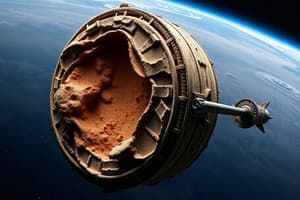Podcast
Questions and Answers
What is the primary focus of trajectory design in mission planning?
What is the primary focus of trajectory design in mission planning?
- Planning the payload integration for scientific experiments
- Calculating the spacecraft's position and velocity in orbit
- Determining the psychological needs of astronauts
- Designing a safe and efficient path for the spacecraft (correct)
Why is orbit determination essential in mission planning?
Why is orbit determination essential in mission planning?
- To ensure that the spacecraft follows its planned trajectory (correct)
- To identify potential threats and assess their likelihood
- To establish reliable communication systems
- To manage resources such as fuel and electricity
What is the purpose of payload integration in space mission planning?
What is the purpose of payload integration in space mission planning?
- To establish reliable communication systems
- To plan the onboard instruments and tools needed for objectives (correct)
- To design a safe path for the spacecraft
- To anticipate and avoid potential hazards
Why do mission planners need to conduct risk assessment and mitigation?
Why do mission planners need to conduct risk assessment and mitigation?
What is a critical aspect of resource management in space missions?
What is a critical aspect of resource management in space missions?
Flashcards are hidden until you start studying
Study Notes
Space Mission: The Art of Exploring the Cosmos
Space missions, fueled by the human thirst for knowledge and wonder, lead us on remarkable journeys that challenge our technological and scientific capabilities. One of the most critical aspects of a successful space mission lies in meticulous planning, particularly in the realm of mission planning.
The Art of Mission Planning
Mission planning is a multifaceted process involving astronomical, engineering, and human factors. The journey to space starts long before a single rocket launches, requiring a thorough understanding of the cosmos and a rigorous analytical approach. Mission planners collaborate with experts in various fields to create a detailed blueprint for a spacecraft's trajectory, activities, resources, and risks.
At the heart of mission planning lies a robust mission design phase, where mission planners establish the primary objectives, timeline, and budget. This phase also involves a thorough analysis of the various launch windows, the ideal times for a spacecraft's launch to reach its destination, and accounts for gravitational forces, celestial bodies, and other astronomical factors.
Key Elements of Mission Planning
Mission planning involves several key elements that have evolved over time, drawing on fundamental principles and techniques that have been refined and perfected by experienced teams.
-
Trajectory Design: This involves designing a safe and efficient path for the spacecraft from launch to landing or arrival at its destination. Trajectory designers consider factors like launch sites, orbital mechanics, and the gravitational forces of celestial bodies.
-
Orbit Determination: Once the spacecraft is in orbit, mission planners use orbit determination algorithms to accurately track its position and velocity. These calculations are essential to ensure that the spacecraft follows its planned trajectory and to anticipate and avoid potential hazards.
-
Payload Integration: Mission planners must ensure that the spacecraft has the necessary equipment to complete its objectives. Payload integration involves the careful planning of onboard instruments, tools, and experiments required for scientific, technological, or commercial endeavors.
-
Risk Assessment and Mitigation: Space exploration is inherently risky, and mission planners must anticipate and mitigate potential hazards. Risk assessment and mitigation involve identifying potential threats, assessing their likelihood, and developing strategies to minimize their impact.
-
Resource Management: Space missions consume vast amounts of resources, including fuel, electricity, and data storage. Mission planners must carefully manage these resources to ensure that the spacecraft has the necessary energy, bandwidth, and fuel to complete its objectives and return home safely.
-
Communications and Navigation: Mission planners must establish reliable communication and navigation systems to track the spacecraft's progress and to facilitate real-time data transmission. This is critical to ensure that mission control can monitor the spacecraft's health, adjust its trajectory, and direct any necessary interventions.
The Human Factor in Mission Planning
Space missions require more than just technical expertise; they also demand a human touch. Mission planners must consider the psychological and physiological needs of the astronauts, ensuring that they remain healthy, motivated, and focused throughout their journey.
Astronauts require specialized training to become space mission-ready. Training programs cover a wide range of topics, including spacecraft operation, emergency procedures, and the psychological demands of long-duration spaceflights. The psychological well-being of astronauts is critical to their success, and mission planners must ensure that they remain engaged, motivated, and able to handle the stressors of space travel.
Conclusion
Space missions are the result of a complex, multifaceted process that relies on the collaboration of experts from diverse backgrounds. Mission planning is a cornerstone of space exploration, providing the framework for successful spacecraft design, launch, and operation. As we continue to explore the cosmos, mission planning will remain a critical component of our quest for scientific knowledge and technological advancement. By understanding and appreciating the efforts involved in mission planning, we can better appreciate the remarkable achievements of space exploration.
Studying That Suits You
Use AI to generate personalized quizzes and flashcards to suit your learning preferences.





